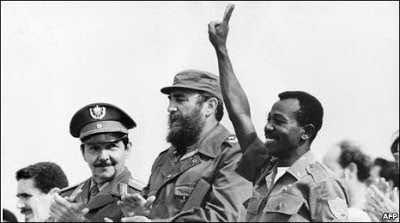It may seem counter intuitive.
The Castro regime is a brutal communist dictatorship that has killed thousands of Cubans, and created a police state terrorizing millions of Cubans. Fidel and Raul Castro along with thousands of their soldiers went to Ethiopia to assist a war criminal consolidate power and commit genocide. The Castro brothers have undermined and compromised democracies in Latin America, turned Venezuela into a colony where thousands of soldiers, and spies torture, rape, and kill Venezuelan dissidents. Havana for over six decades has sponsored international terrorism on several continents and created new terrorist groups that still operate today. It is not an overstatement to say that they are experts in violence and terror.
 |
| L to R: Ramiro Valdes, Raul Castro, Fidel Castro and Mengistu Haile Mariam |
It may seem counter intuitive, but due to the extreme violent and criminal nature of the Castro regime it is nonviolence not violence that has a better chance in ending the Castro dictatorship.
Maciej Bartkowski, an adjunct faculty at Johns Hopkins University, where he teaches strategic nonviolent resistance, in the essay "Nonviolent strategies to defeat totalitarians such as ISIS" makes an unexpected argument for stopping the Middle East terrorist group.
"No single action by itself can dislodge totalitarians and pave the way for more stable societies, but collective actions, like the multipronged, civilian-based, and nonviolent strategies offered in the cited cases, can prove successful against extremely violent groups" ... "These strategies consist of:
- Containment that lets the henchmen rule and erode their own legitimacy in the eyes of locals;
- Grassroots noncooperation against totalitarians, including acts of subtle and overt disobedience, deliberate inefficiencies, and underground solidarity networks;
[...]
- Transnational assistance to nonviolent activists and their civil resistance actions in a violence-torn environment."
The moral rightness of the economic embargo on the Castro regime: containment
Containment is a state strategy of non-cooperation with a hostile power that also avoids complicity with bad actors. In the context of U.S. - Cuba relations the economic embargo when tightened and enforced has constrained the bad actions of the regime. This is why when Cubans took to the streets calling for the end of the dictatorship they did not wave Canadian, Spanish or European Union flags, but the flag of the United States.
These other countries who have maintained "normal" relations with a criminal regime that includes providing subsidies and selling weapons to the dictatorship make them complicit in the crimes of the dictatorship.
The United States has economic sanctions that exempt food and medicine. American companies, due to the Castro dictatorship's monopoly over the economy, can only sell to the regime. The dictatorship is the one exploiting Cubans. For example, American companies sell chicken to Cuba for $1 per kilo and the Castro regime turns around and sales it to Cubans in government stores at $7 per kilo pocketing the difference for the Castros.
The United States also permits millions of Cubans in the United States to send remittances back to their families in Cuba, but out of every $100 sent today, at least $40 dollars are taken by the regime, and their business allies. However, one must weigh the harm done, versus the good in maintaining links between families.
These are not considerations made by Havana.
When the Castro regime was receiving Soviet subsidies and riding high in the world economically they forced Cubans to cut off relations with family living abroad. It was only when the dictatorship needed hard currency from the diaspora that they stopped punishing Cubans on the island having contacts with family abroad.
The power of nonviolent resistance
 |
| Oswaldo Payá, Antonio Diaz, Regis Iglesias turn in petitions to National Assembly 5/10/02 |
Courageous Cubans fought with arms against the dictatorship from the earliest days of the regime well into the 1960s with untold numbers killed, and the regime consolidated.
Beginning in the 1970s a nonviolent human rights movement emerged in the prisons and would win some battles against the dictatorship using grassroots civic resistance tactics and endure to the present day inspiring millions of Cubans on the island and around the world.
Transnational assistance to Cuban nonviolent activists have been measures of concrete solidarity with the Cuban people that draws howls from the dictatorship and their allies, but gratitude from most Cubans.
This may not seem like much, but these methods of containment, nonviolent resistance, and transnational assistance have a better track record in defeating brutal terrorist regimes than armed conflict.
This is why I have been and continue to be vocal in my opposition to calls for violent resistance in Cuba. It is also why I have been and continue to be vocal in my support for the U.S. embargo on the Castro regime and targeted sanctions against regime bad actors, and advocate for transnational assistance to nonviolent dissidents in Cuba.
The U.S. military spent much in blood and treasure waging war against ISIS, and beat them back for a while, but they have not gone away. When it comes to violence, genocidal mass murderers have the advantage. Why fight on their terrain? Force them onto the terrain of nonviolent resistance where millions can challenge the dictatorship in a civic nonviolent manner. The Cuban opposition has been doing that and on July 11th the Castro regime was placed on the defensive when Cubans across the country nonviolently called for freedom and an end to the dictatorship.
Paradoxically, the best way to save the dictatorship and perpetuate its rule would be to abandon nonviolent resistance, in the belief that it would speed up change on the island, but by switching to violence the opposition would be helping the Castro regime by switching to a terrain that they have extensive experience in: violence, terror, and war.





















